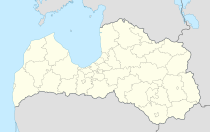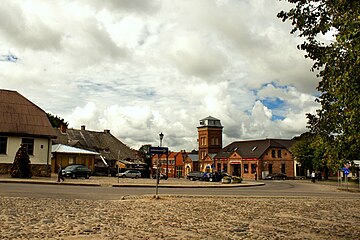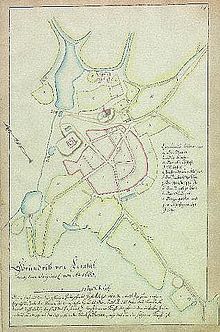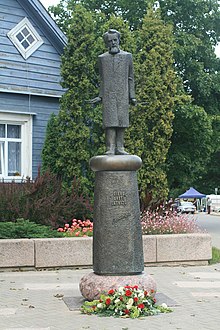Limbaži
| Limbaži ( German : Lemsal) | ||
|---|---|---|
 |
|
|
| Basic data | ||
| State : |
|
|
| Landscape: | Livonia ( Latvian : Vidzeme ) | |
| Administrative district : | Limbažu novads | |
| Coordinates : | 57 ° 31 ' N , 24 ° 43' E | |
| Residents : | 7,805 (Jan 1, 2016) | |
| Area : | 9 km² | |
| Population density : | 867 inhabitants per km² | |
| Height : | 80 m | |
| City law: | since 1385 | |
| Website: | www.limbazi.lv | |
| Post Code: | 4001 | |
| ISO code: | ||
| Old town | ||
Limbaži ( ), Lemsal in German , is a former Hanseatic city in northern Latvia ( Vidzeme region ) and the center of the administrative district of the same name ( Limbažu novads ). In 2016 the city had 7805 inhabitants.
location
The city is located 90 km north of the capital Riga between Valmiera in the east and the Riga Bay , 20 km to the west , on Lake Limbaži.
history
From the 10th century on, the Livonian fortress "Lemesele" existed here at the crossroads of two trade routes. The settlement, which was formed around an order castle that was built in 1223 , received city rights early on and became a member of the Hanseatic League . This makes today's Limbaži one of the oldest cities in historical Livonia .
In 1385, the Archbishop of Riga, Johann IV, assigned land to expand the town and the town charter of Lübeck . The city built ramparts to protect it. At that time the St. Labrencis Church, the guild house (for 3 guilds ) and the town hall stood on the central market square . Around 400 houses belonged to the city. In terms of the number of inhabitants, Lemsal was the second largest city after Riga.
At the beginning of the 16th century, the city's importance as a trading center decreased, as both the Svetupe River (Latvian: Svētupe ) and the nearby Dune Lake (Latvian: Dūņezers ) silted up. The merchant ships could no longer reach the city; Riga and Salacgrīva took over the function of export ports.
During the Livonian War , Lemsal was burned down in 1558 by the troops of Ivan the Terrible , in 1567 by the Swedes and in 1575 by the Russians again . After the repeated occupation by the Swedes in 1602, the castle was completely destroyed and its defensive walls razed . These were not rebuilt afterwards.
The Swedish king Gustav Adolf donated the Limbaži castle to the city of Riga. Since Riga had no interest in the development of competing cities, it subjected the residents of Limbaži to various restrictions that restricted economic life. Still, the city recovered. At the end of the 17th century there were again 44 houses, 2 pubs, a church and a school. In the Lutheran Congregational School, children were also taught in Latvian from 1693.
In 1747 the city burned down within a few hours, only four buildings survived the conflagration. After the reconstruction, further development was quite slow. The historical center of the city still has its old street course, as it was built in 1385 after the construction of the protective wall. Most of the current old town of Limbaži dates from the 18th century and from the end of the 19th century.
A major economic development began in 1877, after Limbaži was released from its previous dependence on Riga by law. A large textile company was founded by A. Tiel as early as 1876, which included a wool spinning mill , dye works , printing works , a hat factory and a weaving mill . In 1913 this company was transferred to a joint Belgian joint-stock company , whose director was J. Husmann.
After Kārlis Baumanis moved from Saint Petersburg to Limbaži in 1882 , a lively cultural life developed in the city. The Limbaži Cultural Society was established and the first public library started its work. There were several printing works in town. The largest was the printing house of Kārlis Paucītis, which was founded in 1901 and existed until 1953.
After the independence of Latvia, the economic boom continued. In addition to the textile industry, the dairy was one of the largest companies.
Educational institutions
- Branch of the Agricultural University of Latvia
- Children's and youth center
- Culture house
- Art school
- Limbaži Museum ( founded in 1983 )
- music school
- theatre
- Central and children's library
- Adult qualification center
Buildings
- the Lutheran St. John's Church, which dates back to 1681. It was designed by the Riga city architect Rupert Bindenschuh .
- the tomb of Kārlis Baumanis , composer and poet of the Latvian national anthem .
- Castle ruins
Regular events
- as a member of the Hanseatic League Limbaži involved in the annual events on the "Hanseatic Days", the Hanseatic Days of Modern Times
- Every year on the first weekend in August, Limbaži celebrates the town festival
- An international theater festival takes place every two years
Others
- There is a city partnership with Anklam (Germany).
- According to stories, the name Limbaži goes back to a Swedish priest who happened to hear the words "Limba" and "āži" (German: billy goat ). He was of the opinion that the combination of these words was a good name for this area and the city has had this name ever since.
people
- Māris Kučinskis (* 1961), politician
- Inese Jursone (* 1981), beach volleyball player
- Artis Lazdiņš (* 1986), football player
- Anete Kociņa (* 1995), javelin thrower
literature
- Hans Feldmann , Heinz von zur Mühlen (Hrsg.): Baltic historical local dictionary, part 2: Latvia (southern Livland and Courland). Böhlau, Cologne 1990, ISBN 3-412-06889-6 , pp. 337–338.
- Astrīda Iltnere (ed.): Latvijas Pagasti, Enciklopēdija. Preses Nams, Riga 2002, ISBN 9984-00-436-8 .








